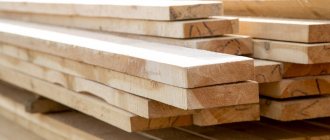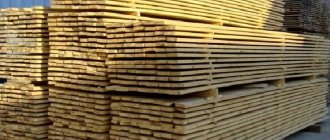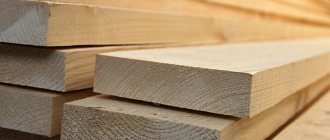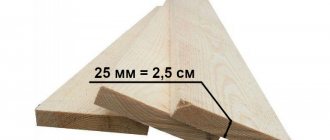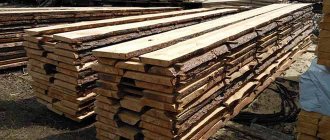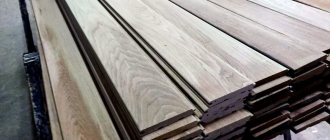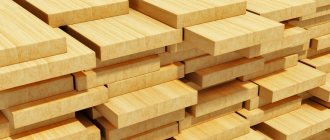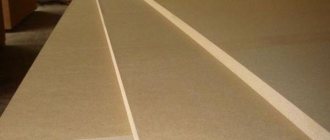The main feature of the sale of lumber is that it is sold in cubic meters. When purchasing lumber on the market, it is not always easy to assess the accuracy of its tempering.
For this purpose, there are special tables of lumber in a cube. The calculation of the amount of lumber in a cube can be influenced by the degree of processing, type and grade. One cubic meter will contain different amounts of edged and unedged boards.
Dense and foldable cubic meter
In units of measurement of lumber, there are two concepts of cubic meter:
- dense cubic meter; folded cubic meter.
A dense measure (cubic meter) is the main accounting method, based on the labor-intensive method of piecemeal measurement of the end diameters and lengths of each log.
The folded cubic meter is an auxiliary unit of accounting, for which the parameters of wood are measured on average. This method is suitable for low-grade lumber, simplifying the measurement of wood stacks without individual counting. The conversion of a folded cubic meter into cubic meters of a dense measure is carried out using the full-wood coefficient.
Cubaturnik is a special table for calculating the cubic capacity of lumber. The diameters of the cubature are located vertically, and the lengths are located horizontally. At the intersection of the vertical and horizontal lines, the volume for each log is obtained.
For which lumber can the calculation calculator be used?
The calculation calculator helps you calculate how many edged and unedged boards are in a cubic meter. It is used for lumber:
Edged boards and timber. Based on the dimensions of a product unit, volume, area, and weight are calculated.
The width of an edged board with non-parallel edges is measured in the middle of the length, the thickness of edged boards is measured anywhere, but no closer than 15 centimeters from the end part of the board. Unedged board (slab). The calculator allows you to calculate cubic capacity, area, weight based on the dimensions of one unit. Edged and rounded logs. Calculation of lumber cubed and volume.
A universal calculator is used to calculate cubic capacity, moldings and quantity of lumber. With its help, one unit of lumber assortment can be easily and quickly converted to another.
Coniferous boards and bars are produced in six grades, the moisture content of each grade is standardized by GOST. Beech lumber comes in four grades.
Medium and large sawn hardwoods are divided into four grades. The GOST text contains a table: how much unedged board fits in a cube depends on its humidity, as well as whether it is deciduous or coniferous. When humidity exceeds 20%, correction factors must be included in the calculations.
Lumber cubic capacity table
Beam100x100x61 pieces - 0.06 cube16.67 pieces per cubeBeam100x150x61 piece - 0.09 cube11.11 pieces per cubeBeam150x150x61 piece - 0.135 cube7.41 pieces per cubeBeam100x200x61 piece - 0.12 cube8.33 pieces per cubeB rus150x200x61 pieces - 0.18 cubic meters5.56 pieces per cubeBeams200x200x61 pieces - 0.24 cubic meters4 .17 pieces per cube Beams 100x100x71 pieces – 0.07 cubic meters 14, 28 pieces per cube Beams 100x150x71 pieces – 0.105 cubes 9.52 pieces per cube Beams 150x150x71 pieces – 0.1575 cubes 6.35 pieces per cube Beams 100x200x71 pieces – 0.14 cube a7.14 pieces per cube Beam 150x200x71 pieces – 0.21 cube 4.76 pieces per cube Beam 200x200x71 piece - 0.28 cube 3.57 pieces per cube Edged board 22x100x61 piece - 0.0132 cube 45.46 m.
sq. in a cube Edged boards 22x150x61 pieces - 0.0198 cubes 45.46 m.
sq. in a cube Edged boards 22 x 200 x 61 pieces - 0.0264 cubic meters 45.46 sq. m.
in a cubeEdged boards 25x100x61 pieces - 0.015 cubic meters 40 sq.m. in a cubeEdged boards 25x150x61 pieces - 0.0225 cubes40 sq.m. in a cubeEdged boards 25x200x61 pieces - 0.03 cubes40 m.
sq. m per cubeEdged board 40x100x61 pieces - 0.024 cubic meters25 sq. m. per cubeEdged board 40x150x61 pieces - 0.036 cube25 sq. m. per cubeEdged board 40x200x61 pieces - 0.048 cube25 m.
sq.m per cubeEdged board 50x100x61 pieces - 0.03 cubic meters 20 sq.m. per cubeEdged board 50x150x61 pieces - 0.045 cubic meters 20 sq.m. per cubeEdged board 50x200x61 pieces - 0.06 cube20 m.
sq. m per cubeEdged board 32x100x61 pieces - 0.0192 cubic meters31.25 sq. m. per cubeEdged board 32x150x61 pieces - 0.0288 cube31.25 sq. m. per cubeEdged board 32x200x61 pieces - 0.0384 cube31.25 m.
sq.m per cubeEdged board 25x100x21 pieces - 0.005 cubic meters 40 sq.m. per cubeEdged board 25x100x71 pieces - 0.0175 cube40 sq.m. per cubeEdged board 25x150x71 pieces - 0.02625 cube40 m.
sq. in a cubeEdged board 25x200x71 pieces - 0.035 cubic meters 40 sq.m. in cube Unedged board 50x61 pieces - 0.071 cube Unedged board 40x61 pieces - 0.05 cube Unedged board 25x61 pieces - 0.0294 cubeRake 22x50x31 pieces - 0.0 033 cubic meters 909 m.p.
in a cubeRake 25x50x31 pieces - 0.00375 cubic 800 m. in a cubeRake 22x50x21 pieces - 0.0022 cube909 m.
p. in a cubeRake 25x50x21 pieces - 0.0025 cube800 m.p.
in a cube Bar 40x40x31 pieces – 0.0048 cubic meters 624.99 m. in a cube Bar 50x50x31 pieces – 0.006 cubic meters 500.01 m.
p. in a cube Bar 40x80x31 pieces - 0.0096 cube 312.51 m. p.
in a cube Bar 50x50x31 pieces – 0.0075 cubic meters 399.99 m. in a cube Floor board 36x106x61 pieces – 0.0229 cubic meters 27.77 m.
sq. in a cube Floor board 36x136x61 pieces - 0.0294 cube 27.77 sq. m.
in a cube Floor board 45x136x61 pieces - 0.0375 cube 21.74 sq. m. cubed
Unedged board is one of the simplest types of lumber.
It is usually used in cases where decorative properties are not important. Sheathing, scaffolding, decking, roof sheathing - for all this, this lumber is often the most profitable option. It is often used in the construction of utility rooms and various rough jobs.
Strengthening the walls of pits, installing formwork, sheds, warehouses - for all these types of work, unedged boards are in wide demand. Sometimes it is also used to create a specific ornate wood-look design in the interiors of restaurants, bars, pubs, cafes, etc.
Unedged board is an advantageous building material for strengthening the walls of pits, formwork, sheds, and warehouses.
An unedged board is a longitudinally sawn log with wane on both sides (it is due to the remains of bark on the wane that a specific design is created). In this regard, it is usually not possible to calculate the cubic capacity of 1 piece of this lumber and, in accordance with it, then estimate the total required cubic capacity.
Unlike an edged board, which has length, thickness and width, an unedged board does not have a fixed width: there is only thickness and length. These parameters are set when sawing logs. But the width depends on what specific place in the log this particular specimen was cut from: from the central part or the one that is closer to the slab. Well, the logs themselves also come in different thicknesses.
In this regard, it is impossible to clearly indicate the dimensions and correctly calculate the cubic capacity of the boards in this case.
You can calculate the average parameters of a conditional 1 piece. But the chances that a specimen pulled at random from a stack will coincide with them are extremely small. Therefore, they usually use a different method for calculating cubic capacity, based on needs.
Table for calculating cubic capacity of lumber.
If, for example, the task is to sheathe a certain building, then you simply need to calculate the total area to be sheathed (the total area of all walls), and then, multiplying it by the required thickness, obtain the required cubic capacity of lumber. For example, you need to cover a building 2.5 m high, 6 m long and 3 m wide with 40 mm boards. We have 4 walls, of which 2-3*2.5 m and 2-6*2.5 m.
Then the total area of the walls will be 3*2.5 + 3*2.5 + 6*2.5 + 6*2.5 = 45 m². Multiply by the thickness - and it turns out 45 m² * 0.04 m = 1.8 m³. The specific width of the individual boards does not matter for the calculation: this does not affect the overall cubic capacity.
However, the average parameters of a conventional 1 piece should still be known, especially since the cubature itself is simple. All lumber is produced in fixed sizes.
In our case, the standard length is 6 m, and the standard thickness options are 25, 40 and 50 mm. If the length is different, the volume is calculated in proportion to 6 meters. So, with a length of 6 m:
- thickness 25 mm - volume 0.0294 m³; 40 mm - 0.05 m³; 50 mm - 0.071 m³.
From here, by the way, it is easy to calculate that with a thickness of 25 mm the width on average is approximately 19 cm, with 40 - about 21 cm, with 50 - about 23 cm. This is logical: thicker boards are usually made from logs of larger diameter.
One of the cheapest types of lumber is unedged board. It is characterized by high decorative properties, but during construction work design often does not play a special role.
Tables for calculating the volumes and areas of various types of boards.
Sheathing, scaffolding, decking, and roof sheathing are often made from this material.
It is widely used in the construction of utility rooms, formwork construction, temporary sheds, storage facilities, and all kinds of rough work. But sometimes - for design purposes: to create a specific finish for untreated wood in the interiors of pubs, bars, restaurants, cafes, etc.
Calculation of the weight of a cubic meter of wood.
An unedged board is simply a log sawn lengthwise with wane on both sides. It is due to the wane, on which the bark often remains, that a specific design effect is achieved. In this regard, the shape of 1 piece of this lumber may vary depending on what part of the log it was cut from.
That is, it is impossible, as in the case of an edged board, to calculate the volume of 1 piece using the formula of a rectangular parallelepiped, and then calculate their number per cubic meter; for this lumber, only the length and thickness are fixed, but not the width.
The width varies over a fairly wide range and depends both on the parameters of the logs themselves and on whether this particular specimen was cut from the middle part of the former trunk or from the side (the one closer to the slab).
Of course, you can calculate the approximate average parameters of one unedged board in each specific case, but this makes little sense. Usually the calculation is made differently - in accordance with the area of the walls.
That is, first the total area is calculated, and then the thickness of the unedged board is taken into account (based on needs).
For example, if it is necessary to sheathe a structure, then calculate the area of its walls and multiply it by the thickness of the boards used. Let's say you need to cover a utility room 4x6 m and 3 m high with boards 25 mm thick. Then there are 2 smaller walls 4x3 m and 2 larger walls 6x3 m.
Their total area is therefore 4x3+4x3+6x3+6x3=60 m². We multiply by the thickness (for this we convert millimeters to meters): 60x0.025 = 1.5 m³. There is no need to take into account the width of individual boards: the overall cubic capacity will not change as a result, and lumber is sold in cubes, not in pieces.
Cube table
Nevertheless, the average parameters of a conditional 1 piece should also be remembered. For an approximate preliminary calculation, this knowledge may be useful. Moreover, the table of cubic capacity of an unedged board itself is simple and consists of only 3 lines.
This lumber is available in three thickness standards: 25, 40 and 50 mm. The standard length is 6 m. The average volumes are as follows:
- if the thickness is 25 mm - the volume is 0.0294 m³; 40 mm - 0.05 m³; 50 mm - 0.071 m³.
The cubic capacity of boards of non-standard length (3 or 4 m, these are also sometimes found on sale) can be calculated from that indicated in the table, multiplying the corresponding value by 0.5 or 2/3.
Calculation of the cubic capacity of boards will depend on whether the board is edged (including planed) or unedged. In the first case, it is easier to calculate the cubic capacity, since the lumber has the correct geometric shape of a parallelepiped. The cubic capacity of an unedged board—one whose sides are unprocessed, fast—is calculated somewhat differently.
Fortunately, calculating the cubic capacity of the board is not difficult. Either the “How many boards in a cube” table or a formula will help you with this. The latter option is more reliable and more accurate.
Types and features of boards
The most convenient and valuable for construction work are dry-edged planed ones. They are used for open areas with the highest quality coatings.
- Rectangular smooth edged ones fit well to each other, forming a flat surface.
- Dry ones will not shrink or turn black, which will ensure durability and beauty.
- They can be tongue-and-groove, i.e. have special grooves for tight joining of elements.
- The grooves and protrusions that fit into them are called tenons. They are not taken into account when measuring.
- That is, the measurement of a board with grooves is carried out to the groove cavity along the working surface area.
For rough structures, not very dry, unedged ones with uneven, rounded, raw edges and bark are suitable. Their end side has the shape of an irregular trapezoid. Determining cubic capacity is difficult.
Cubic capacity of edged boards 20 millimeters thick
Size (mm) m2 in 1 m3 Pieces of boards in 1 m3 Volume of one board (in “cubes”) 100 * 600050830.012120 * 6000690.0144150 * 6000550.018180 * 6000460.0216200 * 6000410.024250 * 6000 330.03
However, you can more accurately calculate the cubic capacity of an edged board using the formula. The formula for the cubic capacity of an edged board is:
a*b*l
where a is the thickness of the board
b – its width
l – its length
The cubic capacity of a board is calculated in cubic meters, so before calculating the cubic capacity of a board, all values are converted from millimeters to meters. For example, let’s take a “magpie” board 40*200*6000: its thickness is 40 mm (0.04 m), width 200 mm (0.02 m), length – 6000 mm (6 m). Now we calculate the cubic capacity of the boards:
0.04*0.2*6=0.048 m3
That is, one “magpie” board 100*6000 has a cubic capacity of 0.048 m3. To determine how many boards are in a cube, all that remains is to divide 1 by the resulting amount:
1/0.048=21 boards in 1 m3.
How many boards are in a cube - table
| Thickness, mm | Width, mm | Length, mm | volume, m3 | Quantity, pcs |
| 20 | 20 | 4000 | 0.0016 | 625 |
| 20 | 50 | 4000 | 0.0040 | 250 |
| 20 | 60 | 4000 | 0.0048 | 208 |
| 20 | 70 | 4000 | 0.0056 | 179 |
| 20 | 80 | 4000 | 0.0064 | 156 |
| 20 | 90 | 4000 | 0.0072 | 139 |
| 20 | 100 | 4000 | 0.0080 | 125 |
| 20 | 120 | 4000 | 0.0096 | 104 |
| 20 | 150 | 4000 | 0.0120 | 83 |
| 20 | 180 | 4000 | 0.0144 | 69 |
| 20 | 200 | 4000 | 0.0160 | 63 |
| 20 | 250 | 4000 | 0.0200 | 50 |
| 20 | 300 | 4000 | 0.0240 | 42 |
| 25 | 20 | 4000 | 0.0020 | 500 |
| 25 | 25 | 4000 | 0.0025 | 400 |
| 25 | 40 | 4000 | 0.0040 | 250 |
| 25 | 50 | 4000 | 0.0050 | 200 |
| 25 | 60 | 4000 | 0.0060 | 167 |
| 25 | 70 | 4000 | 0.0070 | 143 |
| 25 | 80 | 4000 | 0.0080 | 125 |
| 25 | 90 | 4000 | 0.0090 | 111 |
| 25 | 100 | 4000 | 0.0100 | 100 |
| 25 | 120 | 4000 | 0.0120 | 83 |
| 25 | 150 | 4000 | 0.0150 | 67 |
| 25 | 180 | 4000 | 0.0180 | 56 |
| 25 | 200 | 4000 | 0.0200 | 50 |
| 25 | 250 | 4000 | 0.0250 | 40 |
| 25 | 300 | 4000 | 0.0300 | 33 |
| 30 | 20 | 4000 | 0.0024 | 417 |
| 30 | 25 | 4000 | 0.0030 | 333 |
| 30 | 30 | 4000 | 0.0036 | 278 |
| 30 | 40 | 4000 | 0.0048 | 208 |
| 30 | 50 | 4000 | 0.0060 | 167 |
| 30 | 60 | 4000 | 0.0072 | 139 |
| 30 | 70 | 4000 | 0.0084 | 119 |
| 30 | 80 | 4000 | 0.0096 | 104 |
| 30 | 90 | 4000 | 0.0108 | 93 |
| 30 | 100 | 4000 | 0.0120 | 83 |
| 30 | 120 | 4000 | 0.0144 | 69 |
| 30 | 150 | 4000 | 0.0180 | 56 |
| 30 | 180 | 4000 | 0.0216 | 46 |
| 30 | 200 | 4000 | 0.0240 | 42 |
| 30 | 250 | 4000 | 0.0300 | 33 |
| 30 | 300 | 4000 | 0.0360 | 28 |
| 40 | 20 | 4000 | 0.0032 | 313 |
| 40 | 40 | 4000 | 0.0064 | 156 |
| 40 | 50 | 4000 | 0.0080 | 125 |
| 40 | 60 | 4000 | 0.0096 | 104 |
| 40 | 70 | 4000 | 0.0112 | 89 |
| 40 | 80 | 4000 | 0.0128 | 78 |
| 40 | 90 | 4000 | 0.0144 | 69 |
| 40 | 100 | 4000 | 0.0160 | 63 |
| 40 | 120 | 4000 | 0.0192 | 52 |
| 40 | 150 | 4000 | 0.0240 | 42 |
| 40 | 180 | 4000 | 0.0288 | 35 |
| 40 | 200 | 4000 | 0.0320 | 31 |
| 40 | 250 | 4000 | 0.0400 | 25 |
| 40 | 300 | 4000 | 0.0480 | 21 |
| 50 | 50 | 4000 | 0.0100 | 100 |
| 50 | 60 | 4000 | 0.0120 | 83 |
| 50 | 70 | 4000 | 0.0140 | 71 |
| 50 | 80 | 4000 | 0.0160 | 63 |
| 50 | 90 | 4000 | 0.0180 | 56 |
| 50 | 100 | 4000 | 0.0200 | 50 |
| 50 | 120 | 4000 | 0.0240 | 42 |
| 50 | 150 | 4000 | 0.0300 | 33 |
| 50 | 180 | 4000 | 0.0360 | 28 |
| 50 | 200 | 4000 | 0.0400 | 25 |
| 50 | 250 | 4000 | 0.0500 | 20 |
| 50 | 300 | 4000 | 0.0600 | 17 |
| 60 | 60 | 4000 | 0.0144 | 69 |
| 60 | 70 | 4000 | 0.0168 | 60 |
| 60 | 80 | 4000 | 0.0192 | 52 |
| 60 | 90 | 4000 | 0.0216 | 46 |
| 60 | 100 | 4000 | 0.0240 | 42 |
| 60 | 120 | 4000 | 0.0288 | 35 |
| 60 | 150 | 4000 | 0.0360 | 28 |
| 60 | 180 | 4000 | 0.0432 | 23 |
| 60 | 200 | 4000 | 0.0480 | 21 |
| 60 | 250 | 4000 | 0.0600 | 17 |
| 60 | 300 | 4000 | 0.0720 | 14 |
| 70 | 70 | 4000 | 0.0196 | 51 |
| 70 | 80 | 4000 | 0.0224 | 45 |
| 70 | 90 | 4000 | 0.0252 | 40 |
| 70 | 100 | 4000 | 0.0280 | 36 |
| 70 | 120 | 4000 | 0.0336 | 30 |
| 70 | 150 | 4000 | 0.0420 | 24 |
| 70 | 180 | 4000 | 0.0504 | 20 |
| 70 | 200 | 4000 | 0.0560 | 18 |
| 70 | 250 | 4000 | 0.0700 | 14 |
| 70 | 300 | 4000 | 0.0840 | 12 |
| 80 | 80 | 4000 | 0.0256 | 39 |
| 80 | 90 | 4000 | 0.0288 | 35 |
| 80 | 100 | 4000 | 0.0320 | 31 |
| 80 | 120 | 4000 | 0.0384 | 26 |
| 80 | 150 | 4000 | 0.0480 | 21 |
| 80 | 180 | 4000 | 0.0576 | 17 |
| 80 | 200 | 4000 | 0.0640 | 16 |
| 80 | 250 | 4000 | 0.0800 | 13 |
| 80 | 300 | 4000 | 0.0960 | 10 |
| 90 | 90 | 4000 | 0.0324 | 31 |
| 90 | 100 | 4000 | 0.0360 | 28 |
| 90 | 120 | 4000 | 0.0432 | 23 |
| 90 | 150 | 4000 | 0.0540 | 19 |
| 90 | 180 | 4000 | 0.0648 | 15 |
| 90 | 200 | 4000 | 0.0720 | 14 |
| 90 | 250 | 4000 | 0.0900 | 11 |
| 90 | 300 | 4000 | 0.1080 | 9 |
| Thickness, mm | Width, mm | Length, mm | volume, m3 | Quantity, pcs |
| 20 | 20 | 5000 | 0.0020 | 500 |
| 20 | 50 | 5000 | 0.0050 | 200 |
| 20 | 60 | 5000 | 0.0060 | 167 |
| 20 | 70 | 5000 | 0.0070 | 143 |
| 20 | 80 | 5000 | 0.0080 | 125 |
| 20 | 90 | 5000 | 0.0090 | 111 |
| 20 | 100 | 5000 | 0.0100 | 100 |
| 20 | 120 | 5000 | 0.0120 | 83 |
| 20 | 150 | 5000 | 0.0150 | 67 |
| 20 | 180 | 5000 | 0.0180 | 56 |
| 20 | 200 | 5000 | 0.0200 | 50 |
| 20 | 250 | 5000 | 0.0250 | 40 |
| 20 | 300 | 5000 | 0.0300 | 33 |
| 25 | 20 | 5000 | 0.0025 | 400 |
| 25 | 25 | 5000 | 0.0031 | 320 |
| 25 | 40 | 5000 | 0.0050 | 200 |
| 25 | 50 | 5000 | 0.0063 | 160 |
| 25 | 60 | 5000 | 0.0075 | 133 |
| 25 | 70 | 5000 | 0.0088 | 114 |
| 25 | 80 | 5000 | 0.0100 | 100 |
| 25 | 90 | 5000 | 0.0113 | 89 |
| 25 | 100 | 5000 | 0.0125 | 80 |
| 25 | 120 | 5000 | 0.0150 | 67 |
| 25 | 150 | 5000 | 0.0188 | 53 |
| 25 | 180 | 5000 | 0.0225 | 44 |
| 25 | 200 | 5000 | 0.0250 | 40 |
| 25 | 250 | 5000 | 0.0313 | 32 |
| 25 | 300 | 5000 | 0.0375 | 27 |
| 30 | 20 | 5000 | 0.0030 | 333 |
| 30 | 25 | 5000 | 0.0038 | 267 |
| 30 | 30 | 5000 | 0.0045 | 222 |
| 30 | 40 | 5000 | 0.0060 | 167 |
| 30 | 50 | 5000 | 0.0075 | 133 |
| 30 | 60 | 5000 | 0.0090 | 111 |
| 30 | 70 | 5000 | 0.0105 | 95 |
| 30 | 80 | 5000 | 0.0120 | 83 |
| 30 | 90 | 5000 | 0.0135 | 74 |
| 30 | 100 | 5000 | 0.0150 | 67 |
| 30 | 120 | 5000 | 0.0180 | 56 |
| 30 | 150 | 5000 | 0.0225 | 44 |
| 30 | 180 | 5000 | 0.0270 | 37 |
| 30 | 200 | 5000 | 0.0300 | 33 |
| 30 | 250 | 5000 | 0.0375 | 27 |
| 30 | 300 | 5000 | 0.0450 | 22 |
| 40 | 20 | 5000 | 0.0040 | 250 |
| 40 | 40 | 5000 | 0.0080 | 125 |
| 40 | 50 | 5000 | 0.0100 | 100 |
| 40 | 60 | 5000 | 0.0120 | 83 |
| 40 | 70 | 5000 | 0.0140 | 71 |
| 40 | 80 | 5000 | 0.0160 | 63 |
| 40 | 90 | 5000 | 0.0180 | 56 |
| 40 | 100 | 5000 | 0.0200 | 50 |
| 40 | 120 | 5000 | 0.0240 | 42 |
| 40 | 150 | 5000 | 0.0300 | 33 |
| 40 | 180 | 5000 | 0.0360 | 28 |
| 40 | 200 | 5000 | 0.0400 | 25 |
| 40 | 250 | 5000 | 0.0500 | 20 |
| 40 | 300 | 5000 | 0.0600 | 17 |
| 50 | 50 | 5000 | 0.0125 | 80 |
| 50 | 60 | 5000 | 0.0150 | 67 |
| 50 | 70 | 5000 | 0.0175 | 57 |
| 50 | 80 | 5000 | 0.0200 | 50 |
| 50 | 90 | 5000 | 0.0225 | 44 |
| 50 | 100 | 5000 | 0.0250 | 40 |
| 50 | 120 | 5000 | 0.0300 | 33 |
| 50 | 150 | 5000 | 0.0375 | 27 |
| 50 | 180 | 5000 | 0.0450 | 22 |
| 50 | 200 | 5000 | 0.0500 | 20 |
| 50 | 250 | 5000 | 0.0625 | 16 |
| 50 | 300 | 5000 | 0.0750 | 13 |
| 60 | 60 | 5000 | 0.0180 | 56 |
| 60 | 70 | 5000 | 0.0210 | 48 |
| 60 | 80 | 5000 | 0.0240 | 42 |
| 60 | 90 | 5000 | 0.0270 | 37 |
| 60 | 100 | 5000 | 0.0300 | 33 |
| 60 | 120 | 5000 | 0.0360 | 28 |
| 60 | 150 | 5000 | 0.0450 | 22 |
| 60 | 180 | 5000 | 0.0540 | 19 |
| 60 | 200 | 5000 | 0.0600 | 17 |
| 60 | 250 | 5000 | 0.0750 | 13 |
| 60 | 300 | 5000 | 0.0900 | 11 |
| 70 | 70 | 5000 | 0.0245 | 41 |
| 70 | 80 | 5000 | 0.0280 | 36 |
| 70 | 90 | 5000 | 0.0315 | 32 |
| 70 | 100 | 5000 | 0.0350 | 29 |
| 70 | 120 | 5000 | 0.0420 | 24 |
| 70 | 150 | 5000 | 0.0525 | 19 |
| 70 | 180 | 5000 | 0.0630 | 16 |
| 70 | 200 | 5000 | 0.0700 | 14 |
| 70 | 250 | 5000 | 0.0875 | 11 |
| 70 | 300 | 5000 | 0.1050 | 10 |
| 80 | 80 | 5000 | 0.0320 | 31 |
| 80 | 90 | 5000 | 0.0360 | 28 |
| 80 | 100 | 5000 | 0.0400 | 25 |
| 80 | 120 | 5000 | 0.0480 | 21 |
| 80 | 150 | 5000 | 0.0600 | 17 |
| 80 | 180 | 5000 | 0.0720 | 14 |
| 80 | 200 | 5000 | 0.0800 | 13 |
| 80 | 250 | 5000 | 0.1000 | 10 |
| 80 | 300 | 5000 | 0.1200 | 8 |
| 90 | 90 | 5000 | 0.0405 | 25 |
| 90 | 100 | 5000 | 0.0450 | 22 |
| 90 | 120 | 5000 | 0.0540 | 19 |
| 90 | 150 | 5000 | 0.0675 | 15 |
| 90 | 180 | 5000 | 0.0810 | 12 |
| 90 | 200 | 5000 | 0.0900 | 11 |
| 90 | 250 | 5000 | 0.1125 | 9 |
| 90 | 300 | 5000 | 0.1350 | 7 |
| Thickness, mm | Width, mm | Length, mm | volume, m3 | Quantity, pcs |
| 20 | 20 | 6000 | 0.0024 | 417 |
| 20 | 50 | 6000 | 0.0060 | 167 |
| 20 | 60 | 6000 | 0.0072 | 139 |
| 20 | 70 | 6000 | 0.0084 | 119 |
| 20 | 80 | 6000 | 0.0096 | 104 |
| 20 | 90 | 6000 | 0.0108 | 93 |
| 20 | 100 | 6000 | 0.0120 | 83 |
| 20 | 120 | 6000 | 0.0144 | 69 |
| 20 | 150 | 6000 | 0.0180 | 56 |
| 20 | 180 | 6000 | 0.0216 | 46 |
| 20 | 200 | 6000 | 0.0240 | 42 |
| 20 | 250 | 6000 | 0.0300 | 33 |
| 20 | 300 | 6000 | 0.0360 | 28 |
| 25 | 20 | 6000 | 0.0030 | 333 |
| 25 | 25 | 6000 | 0.0038 | 267 |
| 25 | 40 | 6000 | 0.0060 | 167 |
| 25 | 50 | 6000 | 0.0075 | 133 |
| 25 | 60 | 6000 | 0.0090 | 111 |
| 25 | 70 | 6000 | 0.0105 | 95 |
| 25 | 80 | 6000 | 0.0120 | 83 |
| 25 | 90 | 6000 | 0.0135 | 74 |
| 25 | 100 | 6000 | 0.0150 | 67 |
| 25 | 120 | 6000 | 0.0180 | 56 |
| 25 | 150 | 6000 | 0.0225 | 44 |
| 25 | 180 | 6000 | 0.0270 | 37 |
| 25 | 200 | 6000 | 0.0300 | 33 |
| 25 | 250 | 6000 | 0.0375 | 27 |
| 25 | 300 | 6000 | 0.0450 | 22 |
| 30 | 20 | 6000 | 0.0036 | 278 |
| 30 | 25 | 6000 | 0.0045 | 222 |
| 30 | 30 | 6000 | 0.0054 | 185 |
| 30 | 40 | 6000 | 0.0072 | 139 |
| 30 | 50 | 6000 | 0.0090 | 111 |
| 30 | 60 | 6000 | 0.0108 | 93 |
| 30 | 70 | 6000 | 0.0126 | 79 |
| 30 | 80 | 6000 | 0.0144 | 69 |
| 30 | 90 | 6000 | 0.0162 | 62 |
| 30 | 100 | 6000 | 0.0180 | 56 |
| 30 | 120 | 6000 | 0.0216 | 46 |
| 30 | 150 | 6000 | 0.0270 | 37 |
| 30 | 180 | 6000 | 0.0324 | 31 |
| 30 | 200 | 6000 | 0.0360 | 28 |
| 30 | 250 | 6000 | 0.0450 | 22 |
| 30 | 300 | 6000 | 0.0540 | 19 |
| 40 | 20 | 6000 | 0.0048 | 208 |
| 40 | 40 | 6000 | 0.0096 | 104 |
| 40 | 50 | 6000 | 0.0120 | 83 |
| 40 | 60 | 6000 | 0.0144 | 69 |
| 40 | 70 | 6000 | 0.0168 | 60 |
| 40 | 80 | 6000 | 0.0192 | 52 |
| 40 | 90 | 6000 | 0.0216 | 46 |
| 40 | 100 | 6000 | 0.0240 | 42 |
| 40 | 120 | 6000 | 0.0288 | 35 |
| 40 | 150 | 6000 | 0.0360 | 28 |
| 40 | 180 | 6000 | 0.0432 | 23 |
| 40 | 200 | 6000 | 0.0480 | 21 |
| 40 | 250 | 6000 | 0.0600 | 17 |
| 40 | 300 | 6000 | 0.0720 | 14 |
| 50 | 50 | 6000 | 0.0150 | 67 |
| 50 | 60 | 6000 | 0.0180 | 56 |
| 50 | 70 | 6000 | 0.0210 | 48 |
| 50 | 80 | 6000 | 0.0240 | 42 |
| 50 | 90 | 6000 | 0.0270 | 37 |
| 50 | 100 | 6000 | 0.0300 | 33 |
| 50 | 120 | 6000 | 0.0360 | 28 |
| 50 | 150 | 6000 | 0.0450 | 22 |
| 50 | 180 | 6000 | 0.0540 | 19 |
| 50 | 200 | 6000 | 0.0600 | 17 |
| 50 | 250 | 6000 | 0.0750 | 13 |
| 50 | 300 | 6000 | 0.0900 | 11 |
| 60 | 60 | 6000 | 0.0216 | 46 |
| 60 | 70 | 6000 | 0.0252 | 40 |
| 60 | 80 | 6000 | 0.0288 | 35 |
| 60 | 90 | 6000 | 0.0324 | 31 |
| 60 | 100 | 6000 | 0.0360 | 28 |
| 60 | 120 | 6000 | 0.0432 | 23 |
| 60 | 150 | 6000 | 0.0540 | 19 |
| 60 | 180 | 6000 | 0.0648 | 15 |
| 60 | 200 | 6000 | 0.0720 | 14 |
| 60 | 250 | 6000 | 0.0900 | 11 |
| 60 | 300 | 6000 | 0.1080 | 9 |
| 70 | 70 | 6000 | 0.0294 | 34 |
| 70 | 80 | 6000 | 0.0336 | 30 |
| 70 | 90 | 6000 | 0.0378 | 26 |
| 70 | 100 | 6000 | 0.0420 | 24 |
| 70 | 120 | 6000 | 0.0504 | 20 |
| 70 | 150 | 6000 | 0.0630 | 16 |
| 70 | 180 | 6000 | 0.0756 | 13 |
| 70 | 200 | 6000 | 0.0840 | 12 |
| 70 | 250 | 6000 | 0.1050 | 10 |
| 70 | 300 | 6000 | 0.1260 | 8 |
| 80 | 80 | 6000 | 0.0384 | 26 |
| 80 | 90 | 6000 | 0.0432 | 23 |
| 80 | 100 | 6000 | 0.0480 | 21 |
| 80 | 120 | 6000 | 0.0576 | 17 |
| 80 | 150 | 6000 | 0.0720 | 14 |
| 80 | 180 | 6000 | 0.0864 | 12 |
| 80 | 200 | 6000 | 0.0960 | 10 |
| 80 | 250 | 6000 | 0.1200 | 8 |
| 80 | 300 | 6000 | 0.1440 | 7 |
| 90 | 90 | 6000 | 0.0486 | 21 |
| 90 | 100 | 6000 | 0.0540 | 19 |
| 90 | 120 | 6000 | 0.0648 | 15 |
| 90 | 150 | 6000 | 0.0810 | 12 |
| 90 | 180 | 6000 | 0.0972 | 10 |
| 90 | 200 | 6000 | 0.1080 | 9 |
| 90 | 250 | 6000 | 0.1350 | 7 |
| 90 | 300 | 6000 | 0.1620 | 6 |
Calculation of cubic capacity of unedged boards
An unedged board differs from an edged one in that it is not processed on the sides, that is, one side has an irregular shape, and it is impossible to indicate the exact width of an unedged board. This is where difficulties arise with calculating the cubic capacity of unedged boards, which are easier to explain with a specific example.
Unedged board
Suppose you need to cover a rectangular building measuring 5*7 meters and 4 meters high with unedged boards. Your board is 50 millimeters (0.05 m) thick.
First, calculate the finishing area. To do this (remember the school), we multiply the perimeter of the building (two sides by 5, two sides by 7 - a total of 24 meters) by the height - 4 meters. We get 96 m2.
Now we multiply the area by the thickness of the material: 96*0.05=4.8 m3
It turns out that for cladding, the width of each cladding element has virtually no effect on the overall cubic capacity. There are no exact cubic capacity tables for unedged boards and there cannot be, since it is unknown from which part of the log the board was cut and what its thickness is on both sides, but some average data on the cubic capacity of unedged boards can be given:
Thickness of boards (length - 6000 mm) Average volume of one element 250.0294400.05500.071
Types of wood building materials
- Timber is important in the construction of load-bearing structures. The thickness is at least 10 cm, the possible width should not be more than 20 cm. In cross section, the beam has a square or close to square shape. During the construction of a house, beams are also used. They have the same shape, with a square cross-section, but are much smaller. The thickness of the bars cannot be more than 10 cm, and the width cannot be more than twice the thickness.
- Croakers - lateral rounded fragments, which are sawn on one side and retain bark on the other, have not been subjected to any processing. This material is much cheaper than others, and one side retains the natural beauty of the wood. Croaker is used for various types of interior and exterior decoration, making fences and formwork. Cuts with slabs or obapol can be cleared of bark. In this case, you get a beautiful finishing material - a block house.
- Obapol is the first or last cut of a log, processed on one side. They also lay floors, lay out the roof, and decorate the interior.
- Boards are the most commonly used rectangular lumber for various purposes at all stages of construction and decoration of a building, arrangement of a personal plot.
Calculating the cubic capacity of boards: what you need to remember
All board manufacturing companies round the numbers in the direction that is beneficial to them. An error occurs. In general, it’s small, but when it comes to hundreds of cubes or a lack of boards for cladding, the issue becomes acute.
For example, the volume of one board is 0.018 m3, and the manufacturer rounded this figure to 0.02 m3. As a result, instead of the expected 55 boards, you will receive only 50. Therefore, always check with sellers for this information.
We hope our article shed light on questions about how many boards are in a cube, how to calculate the cubic capacity of a board, how many boards are in a cube, and how not to get into trouble when buying lumber.
Tatyana Kuzmenko, member of the editorial board of the online publication “AtmWood. Wood-Industrial Bulletin”
(
10 votes, average: 4.70 out of 5) Loading…
Non-standard
Carefully processed products are not always used for construction and household purposes. Sometimes it is advisable to purchase unedged material, the volume of which is difficult to calculate due to the specific uneven structure of the product. There is also a solution for these cases - ready-made reference reports, from which you can find out how many boards are in 1 cube. The table for them is compiled according to the main average sizes.
The tabular data is for reference only and may differ slightly from the actual data: as already mentioned, products may differ in size by a couple of centimeters in length, for example. Therefore, each time you should pay attention to specific parameters.
It doesn’t matter what kind of lumber is needed for construction. You must be able to independently determine the required volume using formulas, a calculator and tables. This will help you avoid purchasing excess boards and significantly save your budget.
The main feature of the sale of lumber is that it is sold in cubic meters. When purchasing lumber on the market, it is not always easy to assess the accuracy of its tempering. For this purpose, there are special tables of lumber in a cube. The calculation of the amount of lumber in a cube can be influenced by the degree of processing, type and grade. One cubic meter will contain different amounts of edged and unedged boards.
Dense and foldable cubic meter
In units of measurement of lumber, there are two concepts of cubic meter:
- dense cubic meter;
- folded cubic meter.
A dense measure (cubic meter) is the main accounting method, based on the labor-intensive method of piecemeal measurement of the end diameters and lengths of each log.
The folded cubic meter is an auxiliary unit of accounting, for which the parameters of wood are measured on average. This method is suitable for low-grade lumber, simplifying the measurement of wood stacks without individual counting. The conversion of a folded cubic meter into cubic meters of a dense measure is carried out using the full-wood coefficient.
Cubaturnik is a special table for calculating the cubic capacity of lumber. The diameters of the cubature are located vertically, and the lengths are located horizontally. At the intersection of the vertical and horizontal lines, the volume for each log is obtained.
For which lumber can the calculation calculator be used?
- Edged boards and timber. Based on the dimensions of a product unit, volume, area, and weight are calculated. The width of an edged board with non-parallel edges is measured in the middle of the length, the thickness of edged boards is measured anywhere, but no closer than 15 centimeters from the end of the board.
- Unedged board (slab). The calculator allows you to calculate cubic capacity, area, weight based on the dimensions of one unit.
- Edged and rounded logs. Calculation of lumber cubed and volume.
A universal calculator is used to calculate cubic capacity, moldings and quantity of lumber. With its help, one unit of lumber assortment can be easily and quickly converted to another.
Coniferous boards and bars are produced in six grades, the moisture content of each grade is standardized by GOST. Beech lumber comes in four grades. Medium and large sawn hardwoods are divided into four grades. The GOST text contains a table: how much unedged board fits in a cube depends on its humidity, as well as whether it is deciduous or coniferous. When humidity exceeds 20%, correction factors must be included in the calculations.
Lumber cubic capacity table
| timber | 100x100x6 | 1 piece - 0.06 cube | 16.67 pieces per cube |
| timber | 100x150x6 | 1 piece - 0.09 cube | 11.11 pieces per cube |
| timber | 150x150x6 | 1 piece - 0.135 cube | 7.41 pieces per cube |
| timber | 100x200x6 | 1 piece - 0.12 cube | 8.33 pieces per cube |
| timber | 150x200x6 | 1 piece - 0.18 cube | 5.56 pieces per cube |
| timber | 200x200x6 | 1 piece - 0.24 cubic meters | 4.17 pieces per cube |
| timber | 100x100x7 | 1 piece - 0.07 cube | 14, 28 pieces per cube |
| timber | 100x150x7 | 1 piece - 0.105 cube | 9.52 pieces per cube |
| timber | 150x150x7 | 1 piece - 0.1575 cube | 6.35 pieces per cube |
| timber | 100x200x7 | 1 piece - 0.14 cubic meters | 7.14 pieces per cube |
| timber | 150x200x7 | 1 piece - 0.21 cube | 4.76 pieces per cube |
| timber | 200x200x7 | 1 piece - 0.28 cube | 3.57 pieces per cube |
| Edged board | 22x100x6 | 1 piece - 0.0132 cubes | 45.46 sq.m. cubed |
| Edged board | 22x150x6 | 1 piece - 0.0198 cubes | 45.46 sq.m. cubed |
| Edged board | 22x200x6 | 1 piece - 0.0264 cubes | 45.46 sq.m. cubed |
| Edged board | 25x100x6 | 1 piece - 0.015 cube | 40 sq.m. cubed |
| Edged board | 25x150x6 | 1 piece - 0.0225 cube | 40 sq.m. cubed |
| Edged board | 25x200x6 | 1 piece - 0.03 cube | 40 sq.m. cubed |
| Edged board | 40x100x6 | 1 piece - 0.024 cubic meters | 25 sq.m. cubed |
| Edged board | 40x150x6 | 1 piece - 0.036 cube | 25 sq.m. cubed |
| Edged board | 40x200x6 | 1 piece - 0.048 cube | 25 sq.m. cubed |
| Edged board | 50x100x6 | 1 piece - 0.03 cube | 20 sq.m. cubed |
| Edged board | 50x150x6 | 1 piece - 0.045 cube | 20 sq.m. cubed |
| Edged board | 50x200x6 | 1 piece - 0.06 cube | 20 sq.m. cubed |
| Edged board | 32x100x6 | 1 piece - 0.0192 cubes | 31.25 sq.m. cubed |
| Edged board | 32x150x6 | 1 piece - 0.0288 cube | 31.25 sq.m. cubed |
| Edged board | 32x200x6 | 1 piece - 0.0384 cubes | 31.25 sq.m. cubed |
| Edged board | 25x100x2 | 1 piece - 0.005 cube | 40 sq.m. cubed |
| Edged board | 25x100x7 | 1 piece - 0.0175 cube | 40 sq.m. cubed |
| Edged board | 25x150x7 | 1 piece - 0.02625 cube | 40 sq.m. cubed |
| Edged board | 25x200x7 | 1 piece - 0.035 cube | 40 sq.m. cubed |
| Unedged board | 50x6 | 1 piece - 0.071 cube | |
| Unedged board | 40x6 | 1 joke – 0.05 cube | |
| Unedged board | 25x6 | 1 piece - 0.0294 cubes | |
| Rail | 22x50x3 | 1 piece - 0.0033 cube | 909 m.p. cubed |
| Rail | 25x50x3 | 1 piece - 0.00375 cube | 800 m.p. cubed |
| Rail | 22x50x2 | 1 piece - 0.0022 cubes | 909 m.p. cubed |
| Rail | 25x50x2 | 1 piece - 0.0025 cube | 800 m.p. cubed |
| Bar | 40x40x3 | 1 piece - 0.0048 cube | 624.99 m.p. cubed |
| Bar | 50x50x3 | 1 piece - 0.006 cube | 500.01 m.p. cubed |
| Bar | 40x80x3 | 1 piece - 0.0096 cube | 312.51 m.p. cubed |
| Bar | 50x50x3 | 1 piece - 0.0075 cube | 399.99 m.p. cubed |
| Floor board | 36x106x6 | 1 piece - 0.0229 cube | 27.77 sq.m. cubed |
| Floor board | 36x136x6 | 1 piece - 0.0294 cubes | 27.77 sq.m. cubed |
| Floor board | 45x136x6 | 1 piece - 0.0375 cube | 21.74 sq.m. cubed |
When preparing for the construction of a wooden building, house or structure, it would be prudent to first find out the total amount of material needed to completely complete the construction of the object. And when a bar is used in the process, its quantity can be found out using special tables with calculations. Or for this you can use calculations carried out independently.
| ONLY THE BEST TIMBER | FREE LOADING |
| PROMPT DELIVERY IN MOSCOW AND REGION | PAYMENT BOTH IN CASH AND BY BIRTHDAY! |
| CAREFUL STORAGE GUARANTEE | DISCOUNTS FOR WHOLESALE BUYERS |
How to calculate the volume of lumber: edged board
Edged board is the most popular type of lumber, which is slightly more expensive than edged board, because the wood is processed from all sides. To obtain it, the log is sawn lengthwise into boards, and then the side edges are processed; the resulting material has a rectangular shape. The advantages of this sawmill material include greater durability, since harmful microorganisms are removed along with the bark, as well as improved joining with other sawmill materials due to the cleaned sides.
Edged boards undergo additional drying and many processing operations, which increase not only their performance characteristics, but also their price. The price is also affected by the type of wood and type of lumber.
Since the edged boards are identical in size, the cubic capacity will be calculated using a simple formula: V=l*h*a, where l,h,a is the length, height and width, respectively, and V is the volume.
How to calculate the volume of lumber
Whether you are a carpenter or simply purchasing the required cubic volume of lumber based on calculations, the ability to correctly calculate the volume of lumber will help in correctly drawing up estimates and will save you from additional financial expenses.
An additional need to learn how to count the volume of lumber also comes from the fact that this is practically the only type of building material that is sold not individually or by weight, but in cubic meters.
The quality, weight and cost of lumber are influenced by many factors, the surface of the wood (presence of chips, grinding, firing, cracks, etc.), humidity and cutting method, which can be tangential or radial.
The volume of wooden boards, and how it is measured.
First, let's get acquainted with the volume of wooden boards and find out how to calculate it.
The unit of volume of wooden products is 1 (one) cubic meter (cub.m.). Another name: cubic meter or simply cube.
Mathematical definition of a unit of volume: A cubic meter is the volume of a cube with an edge length equal to 1 (one) meter.
The numerical value of the volume is calculated by the formula:
V= L x h x b, where,
V – volume; L – length; h – height; b – width.
In this case, all units of length must be expressed in meters.
Board sizes
Board sizes are usually given in millimeters and written as follows:
25 x 150 x 6000, where
25 – board thickness; 150 – board width; 6000 – board length.
The standard length of boards is 4 or 6 meters. But in fact, it is almost always somewhat larger. So, for a board 4 meters long, the increase can be up to 10-20 cm, and for a board 6 meters long – up to 30 cm. But the other two parameters, height and width, always strictly correspond to the declared dimensions.
Simple geometry
Volume of a rectangular product
The simplest calculation task is to calculate the cubic capacity of a product of the correct shape. From the point of view of geometry, we have before us a rectangular parallelepiped, the volume of which, as is known, is equal to the product of the lengths of all its sides.
An important point: in order to get the result in cubic meters, all dimensions of lumber must first be converted into meters.
Let's calculate the cubic capacity of a product with a cross-section of 200x50 mm and a length of 6 meters.
- Convert dimensions to SI units. In meters they correspond to 0.2x0.05x6;
- Let's multiply these values. 0.2*0.05*6=0.06 m3.
The shape of the edged board is a rectangular parallelepiped.
Price
What is the price of material of a known cubic capacity? As you might guess, it is equal to the product of the number of cubes and the cost of a cubic meter. So, if a cube of lumber costs 6,400 rubles, its unit of 0.06 m3 will cost the buyer 6,400 * 0.06 = 384 rubles.
Number of products per cube
The instructions for calculating the amount of lumber per cubic meter are not much more complicated than those described above.
Here the task is divided into two stages:
- The volume of a unit of lumber is calculated;
- The number of units per cubic meter is calculated as the ratio of 1 cubic meter to the calculated volume.
tongue and groove
How can you calculate the cubic capacity of a tongue and groove flooring with your own hands?
Let's use common sense:
- A tongue and groove lock consists of a groove on one side of the product and a tongue on the other side. In this case, the dimensions of the groove and the ridge are equal to each other with a minimum error;
- Accordingly, we can simply discard the size of the tongue and neglect the groove, calculating the cubic capacity of a unit of lumber without a lock. To obtain m3 for one board, its working width is multiplied by thickness and length.
The shape of the product makes it possible to neglect the size of the tongue-and-groove lock.
